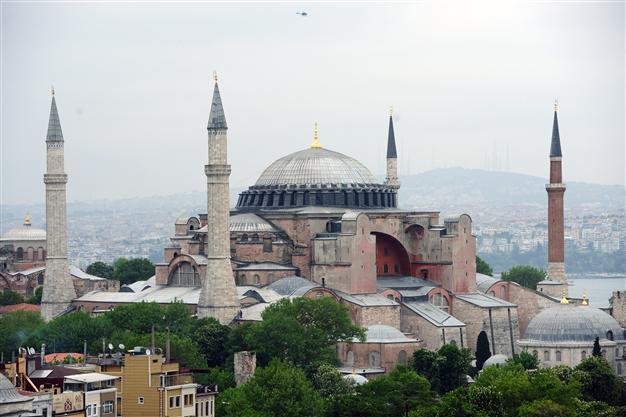Earthquakes pose threat to historic monuments in Istanbul
ISTANBUL – Anadolu Agency

Despite standing tall for centuries, the Hagia Sophia has suffered much damage from earthquakes over the centuries.
Earthquakes continue to pose a serious threat to Istanbul’s historic monuments, experts have warned.
With the city located on the North Anatolian Fault, one of the largest active fault lines in the world, more than 30 earthquakes with magnitudes larger than 7 have hit Istanbul over the last 2,000 years.
The most recent devastating tremor occurred in 1999, leveling the northeastern Turkish city of İzmit, some 80 kilometers from Istanbul. The epicenter of the 7.4 magnitude earthquake was about 11 kilometers south of İzmit and resulted in the deaths of 18,000 people.
Located in one of the most seismically active regions in the world, the preservation of Istanbul’s historic fabric is clearly at risk, warned Reşat Oyguç, chairman of the Workshop on Seismic Risks of Historic Structures, which gave a conference on Nov. 3.
“It is in well-known that earthquakes have caused significant damage to Istanbul’s historic structures for centuries,” Oyguç said.
“The city is struck by a medium-intensity earthquake every 50 years and experiences a severe earthquake every 300 years,” he added.
Although the seismic center was located far away, the İzmit earthquake damaged many historic monuments and structures in Istanbul. Libraries and museums also saw damage, including the Museum of Turkish and Islamic Arts, the Topkapı Palace Museum, the Beyazıt Library, the Süleymaniye Library, the Dolmabahçe Palace Museum and the Istanbul Painting and Sculpture Museum.
“Istanbul still falls behind many large cities in the world with regard to the preservation and performance-based evaluation of its historic monuments … Let’s take example of the Hagia Sophia, one of the most well-known historic monuments in the world as well as one of the oldest structures in Istanbul,” Oyguç said.
“It is important to have access to exact engineering information in order to understand the structure itself as well as its vulnerabilities. Because accurate engineering is the first step to developing efficient conservation proposals for the transmission of the monument to future generations,” he added.
The Hagia Sophia was built in the 6th century as a church, and the building has suffered much damage from earthquakes throughout its long history.
The building almost collapsed due to an earthquake in 557, just 20 years after it was built, while it was also exposed to another devastating earthquake in 1346. It is currently in the middle of an extensive restoration process.
Beste Alperat, from the Middle East Technical University’s Faculty of Architecture, said buildings like Hagia Sophia are retrofitted with new parts from stronger materials in order to protect them from earthquakes, but this process can damage the structures.
“Retrofitting practices may damage or destroy the most significant features of such buildings,” Alperat warned.
